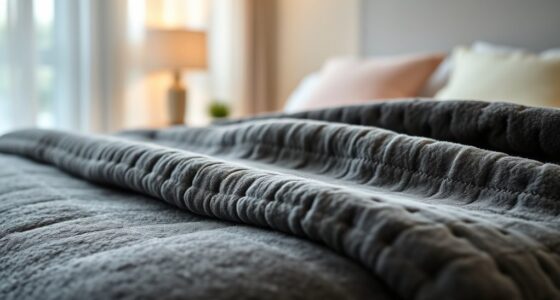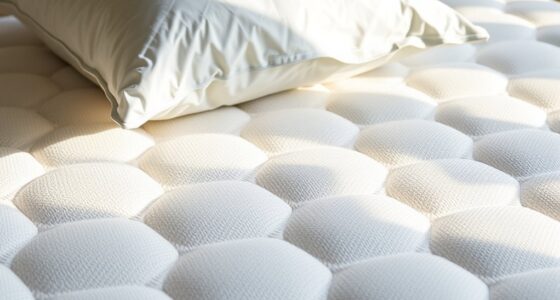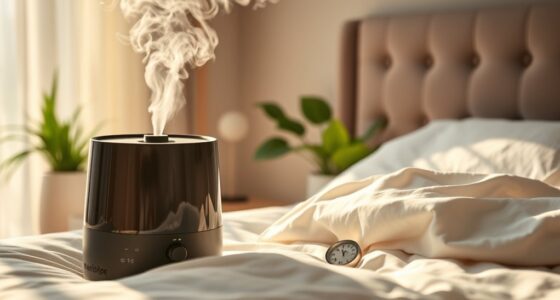For the best sleep, keep your bedroom between 60-67°F (15-19°C). Cooler environments help your body lower its temperature naturally, improving sleep quality and supporting circadian rhythms. Avoid warmer rooms above 70°F, which can cause discomfort and fragmented sleep. Everyone’s preferences differ, so adjust based on your comfort and bedding choices. To learn more about scientifically backed tips for a perfect sleep climate, keep exploring these expert insights.
Key Takeaways
- The optimal bedroom temperature for most adults is between 60-67°F (15-19°C) to promote restorative sleep.
- Cooler environments support natural body cooling and stable REM sleep, enhancing overall sleep quality.
- Personal comfort, age, and bedding materials influence ideal temperature ranges for individual sleep needs.
- Proper airflow and humidity control prevent overheating or chills, creating a consistent sleep-friendly climate.
- Avoid excessively warm or cold rooms, as temperatures outside the recommended range can disrupt sleep cycles.
The Science Behind Sleep and Temperature Regulation
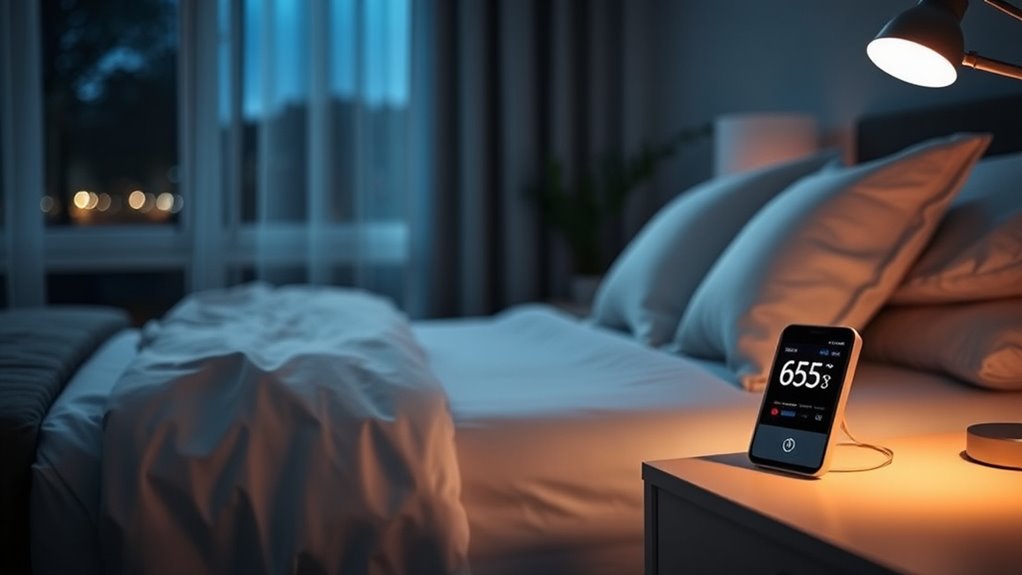
Understanding how your body regulates temperature is essential for a good night’s sleep. Your body relies on thermal insulation and air circulation to maintain the right temperature. Thermal insulation, like a cozy mattress or bedding, helps trap heat when you’re cold and prevent excess warmth when you’re hot. Proper air circulation, on the other hand, allows heat to dissipate and keeps air moving around you, preventing overheating. When your sleep environment balances these factors, your body can adjust its internal temperature more effectively, making it easier to fall asleep and stay asleep. Without good thermal insulation or proper airflow, you might experience discomfort from being too hot or cold, disrupting your sleep cycle. So, understanding these processes helps you optimize your sleep environment for restful nights.
How Body Temperature Affects Sleep Quality
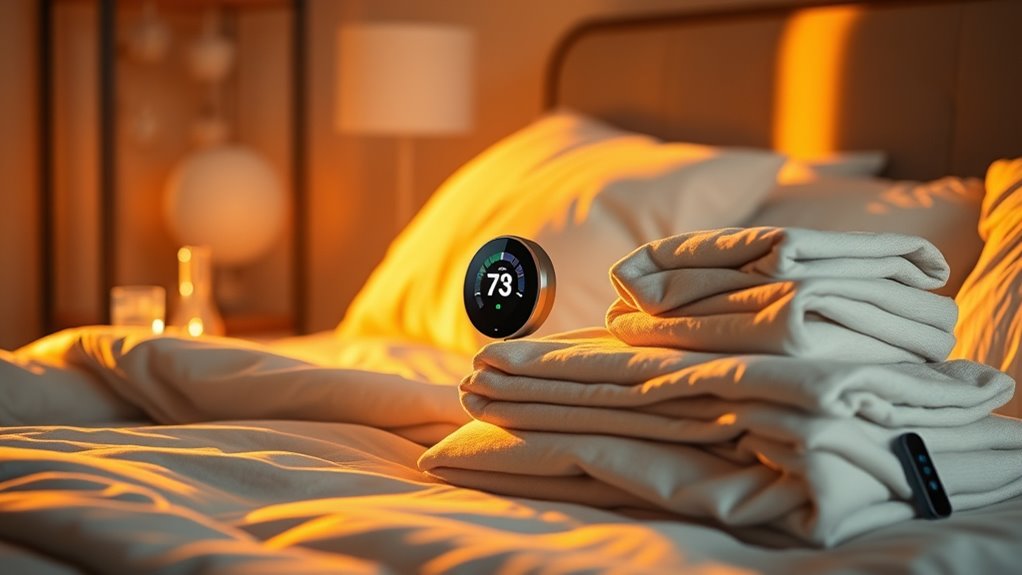
Your body’s temperature plays a vital role in how well you sleep, especially during different sleep stages. When your body is too warm or too cold, it can disrupt your rest and reduce sleep quality. Specifically, temperature changes can impact REM sleep, making it harder for you to feel refreshed in the morning.
Body Heat and Sleep
Body temperature plays a crucial role in determining sleep quality, as your body’s natural temperature cycle influences how easily you fall asleep and stay asleep throughout the night. As your body cools down, it signals that it’s time to rest, making you more likely to drift off quickly. Conversely, when body heat remains high, you might find it harder to settle in. Your sleep environment also impacts this process; a cooler room helps facilitate the natural drop in body temperature needed for restful sleep. Maintaining an ideal balance between your body heat and the surrounding temperature creates the perfect conditions for quality sleep. Using appropriate headphones can help create a quiet, comfortable environment conducive to better sleep. Paying attention to both your body’s heat and your sleep environment can considerably improve your sleep experience overnight.
Temperature’s Impact on REM
Since body temperature fluctuations can influence not just falling asleep but also the quality of REM sleep, maintaining ideal thermal conditions is crucial for restorative rest. Your sleep environment and temperature preferences directly impact REM cycles. Cooler body temperatures promote more stable REM sleep, leading to better dreaming and memory consolidation. Conversely, an environment that’s too warm can disrupt this phase, reducing sleep quality. The table below highlights key factors:
| Temperature Range | Impact on REM | Recommendations |
|---|---|---|
| 60-67°F | Optimal | Keep bedroom cool and well-ventilated |
| 68-72°F | Slightly warm | Use fans or adjust bedding |
| Above 72°F | Disruptive | Lower thermostat or use cooling devices |
Adjusting your sleep environment to match your temperature preferences ensures better REM sleep and overall restfulness. Maintaining proper sleep conditions also helps maximize sleep quality, supporting overall health and well-being.
Optimal Temperature Range for Different Age Groups
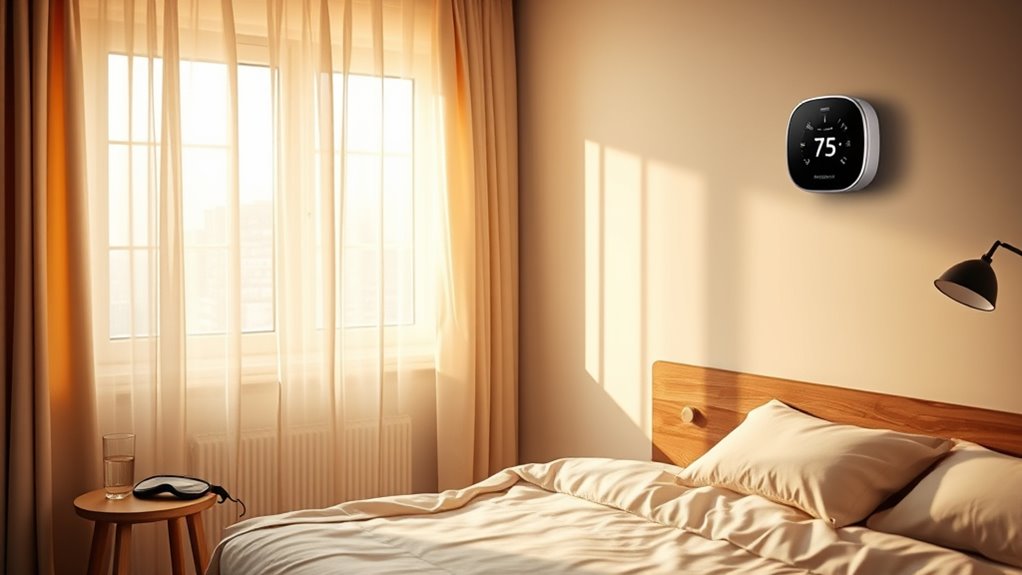
Understanding the ideal temperature range for different age groups is essential to guarantee comfort and health. For infants and young children, a slightly warmer environment, around 68-70°F (20-21°C), helps promote longer sleep duration and minimizes sleep disturbance. Older adults often prefer a cooler setting, about 65-67°F (18-19°C), since aging can affect temperature regulation and increase sensitivity to cold. Teenagers and young adults typically sleep best between 66-70°F (19-21°C). Maintaining these ranges reduces the risk of sleep disruption caused by discomfort. Keep in mind that individual preferences may vary, so adjusting the thermostat within these ranges can help ensure restful sleep tailored to each age group’s needs. Proper temperature management supports better sleep quality across all ages, especially considering the importance of AI safety measures in developing reliable smart home systems.
The Impact of Cooler vs. Warmer Bedrooms on Sleep Cycles
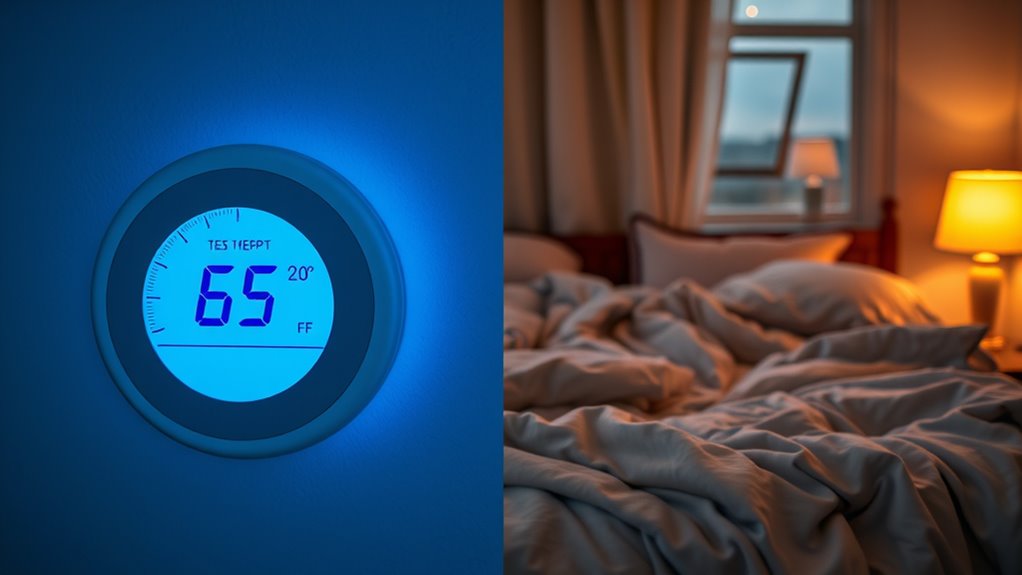
The temperature of your bedroom directly influences your sleep cycles, with cooler environments often promoting deeper, more restorative sleep. A comfortable sleep environment helps your body regulate its internal temperature, supporting essential sleep stages. Cooler bedroom climates encourage faster sleep onset and reduce wakefulness during the night. Warmer rooms, on the other hand, can cause discomfort, fragmented sleep, and difficulty entering deep sleep stages. To maximize your sleep cycles, aim for a bedroom temperature between 60-67°F (15-19°C). Below is a quick guide to how different temperatures impact your sleep environment:
| Temperature Range | Effect on Sleep | Recommendations |
|---|---|---|
| 60-67°F | Promotes deep, restorative sleep | Ideal for most adults |
| 68-72°F | May cause light sleep disruptions | Slightly warmer, less optimal |
| Above 72°F | Increases wakefulness, discomfort | Avoid for quality sleep |
Maintaining the optimal temperature can also complement a farmhouse bedroom aesthetic, creating a cozy yet functional space conducive to restful sleep.
Temperature and Melatonin Production: What’s the Connection?
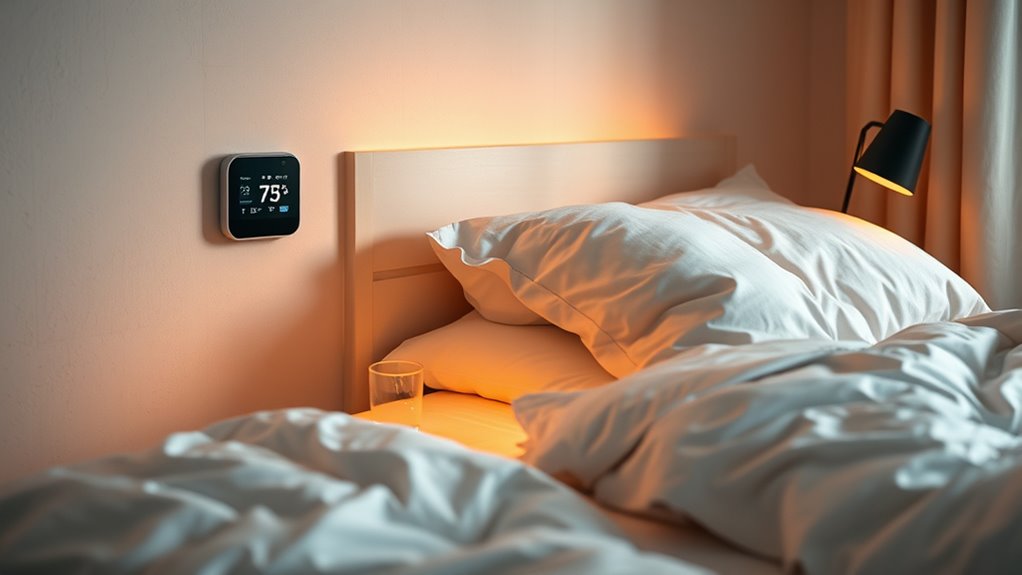
Your sleep environment’s temperature doesn’t just affect how quickly you fall asleep or how restful your sleep is; it also influences your body’s natural production of melatonin. When the room gets too warm, melatonin suppression can occur, disrupting your circadian rhythm—the internal clock that regulates sleep-wake cycles. Elevated temperatures interfere with the signals your body receives about bedtime, making it harder for melatonin levels to rise naturally. Conversely, cooler temperatures support ideal melatonin production, signaling to your body that it’s time to sleep. Maintaining an ideal bedroom temperature helps preserve your circadian rhythm, ensuring consistent melatonin release and better sleep quality. Proper temperature regulation is essential for creating an environment conducive to restful sleep, as it directly impacts melatonin levels and overall sleep health. So, keeping your room at the right temperature isn’t just about comfort—it’s key to supporting your body’s sleep-wake harmony.
Environmental Factors That Influence Your Ideal Sleep Temperature
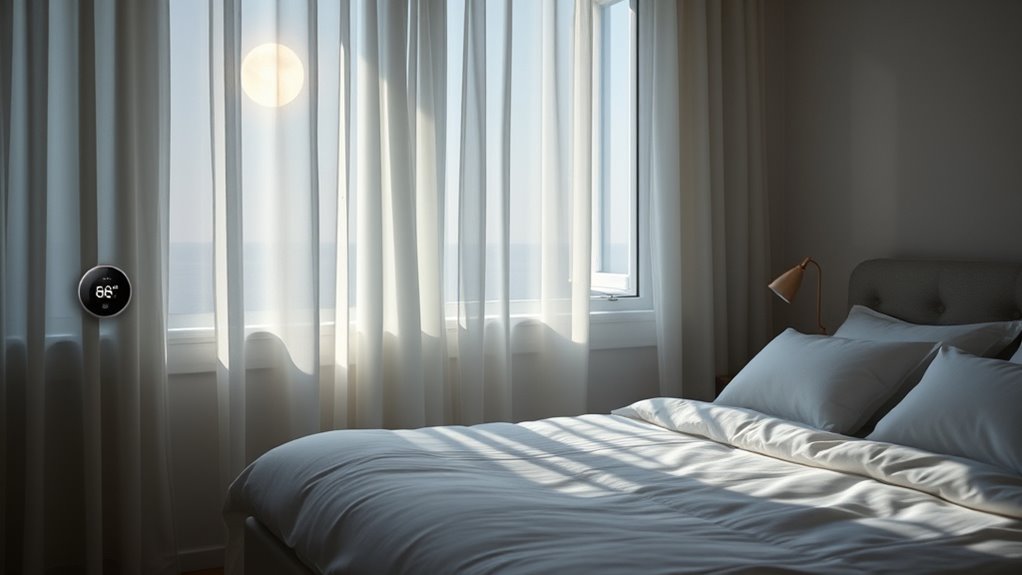
Your room temperature plays a vital role in how comfortably you sleep, but personal preferences vary widely. Factors like your bedding, clothing, and individual sensitivity also influence the ideal sleep environment. Understanding these environmental factors helps you create a setting that promotes restful, undisturbed sleep.
Room Temperature Impact
Have you ever wondered how the temperature of your room affects your sleep quality? Your room’s temperature influences more than just comfort; it impacts your overall sleep. Humidity levels play a vital role—too much moisture can cause discomfort and disrupt REM sleep, while too little can cause dryness and irritation. Proper air circulation helps regulate temperature and humidity, preventing hotspots and stale air that can lead to restless nights. If your room feels stuffy or humid, you might toss and turn more. Conversely, good airflow keeps the environment fresh and maintains a consistent temperature, supporting your body’s natural cooling process during sleep. Maintaining ideal room temperature, with balanced humidity and airflow, is essential for restorative sleep. Additionally, understanding how industrial juice manufacturing processes impact the preservation of nutrients can inspire healthier choices in your diet.
Personal Comfort Variability
While maintaining a stable room temperature benefits most sleepers, individual comfort levels can vary considerably based on personal factors. Your personal preference and climate adaptation shape what feels just right for you. Some people prefer a cooler environment, while others find warmth more soothing. Your body’s natural responses, recent exposure to different temperatures, and even genetics influence your ideal sleep temperature. Consider this table:
| Personal Preference | Climate Adaptation |
|---|---|
| Cooler sleeping temps | Adjusted after long hot summers |
| Warmer environment | More comfortable after cold winters |
| Sensitive to cold | Needs extra blankets or warmer room |
Additionally, behavioral factors such as bedtime routines and sleep environment can also impact your comfort level. Your comfort is deeply personal, and understanding these factors helps you find the sleep environment that truly works for you.
Tips for Maintaining the Perfect Bedroom Climate

Achieving the ideal bedroom temperature requires a combination of practical adjustments and mindful habits. To optimize your sleep environment, focus on managing bedroom humidity and temperature consistently. Use a humidifier or dehumidifier to keep the air comfortable, as too much humidity can cause discomfort, while too little can dry out your skin and airways. Keep your thermostat steady, ideally around 60-67°F, and avoid drastic temperature fluctuations. Ensure good airflow by opening windows when needed or using fans. Additionally, consider blackout curtains to maintain consistent room conditions and reduce external temperature influences. Proper air circulation can also help prevent hot or cold spots in your room, creating a more uniform and comfortable climate. These simple strategies help you create a stable, cozy sleep environment, making it easier to fall asleep and stay asleep throughout the night.
The Role of Bedding and Sleepwear in Temperature Control
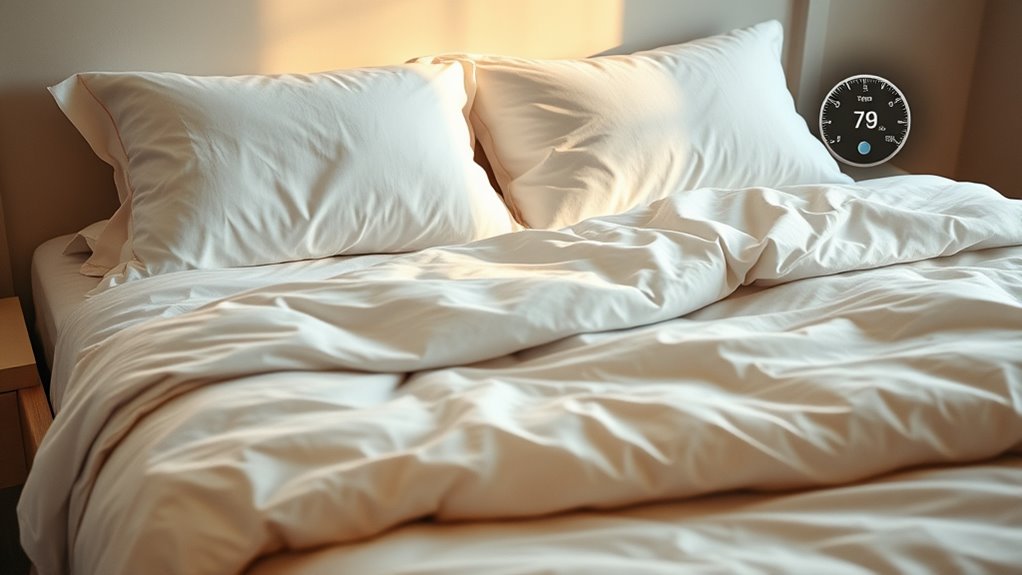
The right bedding and sleepwear can make a significant difference in maintaining a comfortable temperature throughout the night. Choosing breathable sleepwear enhances sleepwear comfort and helps regulate your body heat, preventing overheating or chills. Opt for lightweight, moisture-wicking fabrics like cotton or linen to stay cool if you tend to sweat, or layered options for warmth. Bedding insulation also plays a vital role; thicker blankets offer more warmth, while lighter ones prevent overheating. Consider using a duvet with adjustable covers or switching between different blankets based on the season. Proper bedding and sleepwear work together to optimize your body’s temperature, ensuring you stay comfortable and sleep soundly throughout the night. Additionally, exploring Hyundai tuning options can improve vehicle climate control systems, providing further comfort during your drive or rest periods.
Common Myths About Bedroom Temperature Debunked
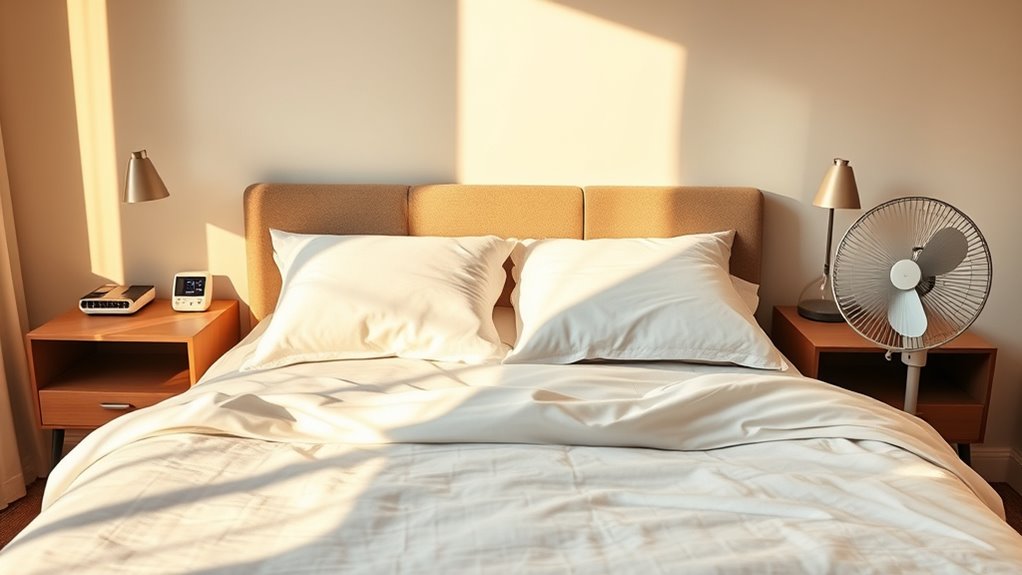
Many believe that cranking up the heat or cooling the room always guarantees better sleep, but that’s not true. Your sleep quality depends on more than just temperature, and clothing or bedding choices play a big role. Additionally, room size doesn’t automatically determine how hot or cold it stays, so myths about heat distribution often mislead you. Moreover, innovations like Intelligent Tutoring Systems (ITS) demonstrate how personalized adjustments and technology can optimize environments for better well-being and productivity.
Temperature and Sleep Quality
Despite common beliefs, the idea that a cooler bedroom always guarantees better sleep isn’t entirely accurate. Your ideal sleep environment varies, and thermostat settings should reflect personal comfort. Too cold or too hot can interrupt your rest, so find a balance that feels right. Remember, sleep quality depends on more than just temperature; other factors like humidity and airflow matter too.
Consider these points:
- Your perfect temperature depends on personal preference, not just a standard number
- Adjusting thermostat settings can improve sleep quality without making the room uncomfortably cold
- Creating a comfortable sleep environment involves more than temperature, including ventilation and humidity control
Ultimately, focus on what makes you feel most comfortable for restful sleep.
Clothing and Bedding Myths
While adjusting your thermostat can influence sleep, what you wear and use in bedding play just as vital roles. Many clothing myths suggest that wearing heavy pajamas helps retain warmth, but overdressing can trap heat and disrupt sleep. Conversely, thin or breathable fabrics prevent overheating. Bedding myths often claim that multiple blankets always improve comfort, but too many can cause sweating and disturb rest. The key is choosing lightweight, moisture-wicking materials that regulate temperature naturally. Avoid the misconception that you must bundle up excessively; instead, aim for clothing and bedding that adapt to your body’s needs. Proper layering with breathable fabrics ensures you stay comfortable without overheating or feeling chilled, making your sleep environment more conducive to quality rest.
Room Size and Heat
A common myth is that larger bedrooms require higher temperatures to stay comfortable, but room size alone doesn’t determine the ideal temperature. Factors like window placement and room insulation have a bigger impact on heating needs. Poorly insulated rooms lose heat faster, regardless of size, while well-insulated spaces retain warmth efficiently. Similarly, window placement influences heat retention—large windows or those facing the sun can either boost warmth or cause heat loss if not properly insulated. By focusing on enhancing insulation and considering window placement, you can maintain a comfortable temperature without overcompensating for room size. This approach helps you save energy and avoid unnecessary heating costs, making your bedroom both cozy and efficient.
Practical Ways to Adjust Your Room Temperature for Better Sleep
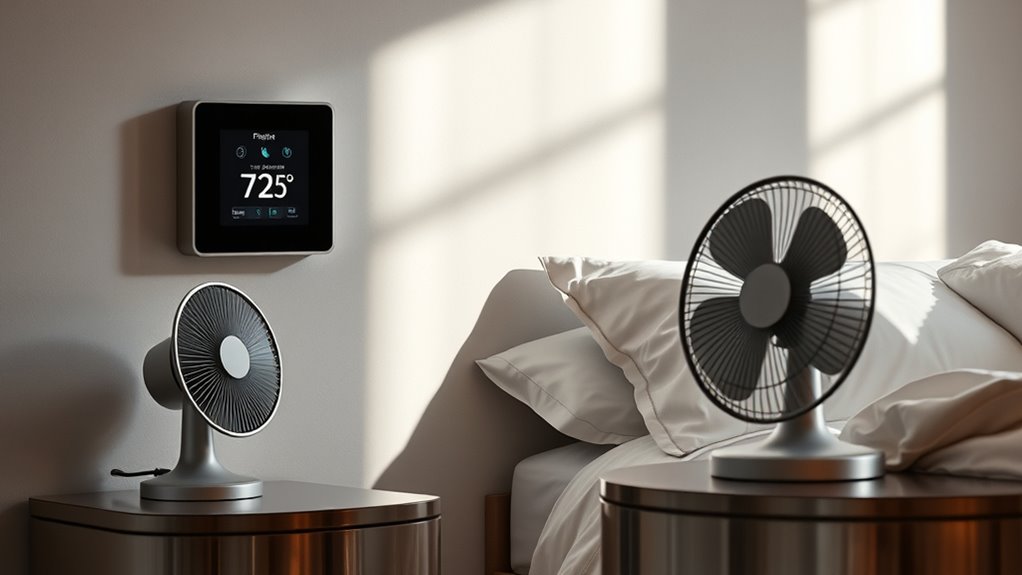
Adjusting your room temperature is one of the simplest ways to improve your sleep quality. Start by optimizing your bedroom layout to promote better air circulation. Keep furniture away from vents and windows to prevent blockages that trap warm or stale air. Use ceiling or oscillating fans to circulate air evenly, helping maintain a consistent temperature. Consider using a programmable thermostat to set your ideal sleep temperature automatically. Opening windows in the evening can also help cool the room naturally, especially if outside temperatures drop. Avoid placing electronics or heat-producing devices near your bed, as they can raise local temperatures. By focusing on bedroom layout and air circulation, you create a more comfortable environment, making it easier to fall asleep and stay asleep.
Frequently Asked Questions
How Does Humidity Affect the Ideal Bedroom Temperature for Sleep?
Humidity levels critically impact your sleep comfort by influencing how the temperature feels. When humidity is high, it makes the air feel warmer and can cause discomfort, so lowering the bedroom temperature helps you stay cool. Conversely, low humidity can make the air feel colder, so slightly increasing the temperature can improve sleep. Maintaining balanced humidity levels around 40-60% guarantees ideal comfort, allowing your perfect bedroom temperature to support restful sleep.
Can Temperature Preferences Change With Different Sleep Disorders?
You might find that your temperature preferences change with different sleep disorders because thermal adaptation varies, impacting comfort. Sleep stage variability can also influence how you perceive temperature, making certain environments more or less comfortable during different sleep phases. These factors mean your ideal bedroom temperature could shift as your body’s regulation adjusts to your disorder, so customizing your environment can help improve sleep quality.
Does Ambient Noise Influence Temperature Perception During Sleep?
Imagine your sleep as a delicate dance, where ambient noise like white noise or sound masking acts as a gentle conductor. It can soften sharp temperature perceptions, creating a cozy cocoon. When noise fills the room, it masks subtle sounds and sensations, making you less aware of temperature fluctuations. So, yes, ambient noise influences how you perceive temperature during sleep, helping you stay comfortable and drift into peaceful slumber.
How Do Seasonal Changes Impact the Optimal Sleep Temperature?
Seasonal changes definitely impact your ideal sleep temperature. You should consider seasonal temperature adjustments to stay comfortable and support circadian rhythm regulation. When it’s colder, you might need warmer bedding or slightly higher room temps, while hotter seasons call for cooler settings. Adapting your sleep environment helps maintain your body’s internal clock, improves sleep quality, and guarantees you wake up refreshed regardless of the season.
Are There Specific Temperature Recommendations for Children With Sleep Issues?
Think of pediatric sleep like a delicate dance where temperature regulation is key. For children with sleep issues, keep the room slightly cooler, around 65-70°F, to promote better sleep. Unlike adults, their bodies need more help maintaining ideal temperature. You should aim for a consistent, comfortable environment that supports their unique needs, helping them fall asleep faster and stay asleep longer, ensuring better pediatric sleep overall.
Conclusion
Just like Goldilocks found her “just right” porridge, you can discover your perfect sleep temperature. By understanding the science behind temperature regulation, you’ll set the stage for restful nights and energized mornings. Don’t forget, a cozy bed and the right climate turn your bedroom into a sanctuary—your own personal Temple of Sleep, where dreams flourish and mornings feel like a fresh start. Sweet dreams await when you get the temperature just right.



